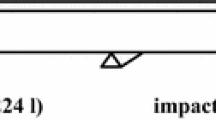Abstract
Understanding the inherent damping mechanisms of floor vibrations has become a matter of increasing importance following the development of new composite floor layouts and increased span. The present study focuses on the evaluation of material damping in timber beam specimens with dimensions that are typical of common timber floor structures. Using the impact test method, 11 solid wood beams and 11 glulam beams made out of Norway Spruce (Picea abies) were subjected to flexural vibrations. The tests involved different spans and orientations. A total of 420 material damping evaluations were performed, and the results are presented as mean values for each configuration along with important statistical indicators to quantify their reliability. The consistency of the experimental method was validated with respect to repeatability and reproducibility. General trends found an increasing damping ratio for higher modes, shorter spans, and edgewise orientations. It is concluded from the results that material damping of timber beams of structural dimensions is governed by shear deformation, which can be expressed more conveniently with respect to the specific mode shape and its derivatives.





Similar content being viewed by others
References
Abaqus Analysis User’s manual, version 6.9 (2010). Dassault Systèmes Simulia Corp., Providence
Allemang RJ (2003) The modal assurance criterion: twenty years of use and abuse. J Sound Vib 37(8):14–23
Brancheriau L, Kouchade C, Bremaud I (2010) Internal friction measurement of tropical species by various acoustic methods. J Wood Sci 56:371–379
Brémaud I, Gril J, Thibaut B (2011) Anisotropy of wood vibrational properties: dependence on grain angle and review of literature data. Wood Sci Technol 45(4):735–754
Bucur V (2006) Acoustics of wood, 2nd edn. Springer, Berlin
De Silva CW (2005) Vibration and shock handbook. Taylor & Francis, Boca Raton
European Committee for Standardization (1999) NS-EN 1194-Timber structures-Glued laminated timber—Strength classes and determination of characteristic values. Brussels
European Committee for Standardization (2005) EUROCODE 5: design of timber structures-Part 1-1: general—Common rules and rules for buildings. Brussels
European Committee for Standardization (2009) NS-EN 338-Structural timber—Strength classes. Brussels
Ewins DJ (2000) Modal testing: theory, practice and application. Research Studies Press, Baldock
Foster CG (1992) Damping and poisson factor behaviour in timber considered as an orthotropic material: Part 1: the loss factor. J Sound Vib 158(3):405–425
Fukada E (1950) The vibrational properties of wood I. J Phys Soc Jpn 5:321–327
Fukada E (1951) The vibrational properties of wood II. J Phys Soc Jpn 6:417–421
Havimo M (2009) A literature-based study on the loss tangent of wood in connection with mechanical pulping. Wood Sci Technol 43(7):627–642
Hwang SJ, Gibson RF (1991) The effects of three-dimensional states of stress on damping of laminated composites. Compos Sci Technol 41(4):379–393
International Organization for Standardization (2010) ISO 21748:2010 Guidance for the use of repeatability, reproducibility and trueness estimates in measurement uncertainty estimation. Geneva
Joint Committee on Structural Safety (2007) Probabilistic Model Code: Part III: Resistance Models: Timber
Kimball AL, Lovell DE (1927) Internal friction in solids. Phys Rev 30(6):948–959
Kollmann F, Krech H (1960) Dynamic measurement of damping capacity and elastic properties of wood. Werkstoffprüfung 18(2):41–54
Krueger F, Rohloff E (1938) About the internal friction of wood: Über die innere Reibung von Holz. Z Phys 110:58–68
Kume Y, Hashimoto F, Maeda S (1982) Material damping of cantilever beams. J Sound Vib 80(1):1–10
Lazan BJ (1968) Damping of materials and members in structural mechanics. Pergamon Press, Oxford
Matsumoto T (1962) Studies on the dynamic modulus E and the logarithmic decrement of wood by transverse vibration. Bull Kyushu Univ For 36:1–86
Ministry of Environment of British Columbia (2001) Outliers: a guide for data analysis and interpreters on how to evaluate unexpected high values. Vancouver, Canada
Minitab Inc (2010) Minitab StatGuide. State College
Nakao T, Okano T, Asano I (1985) Theoretical and experimental analysis of flexural vibration of the viscoelastic Timoshenko beam. J Appl Mech 52:728–731
National Instruments (2011) Modal Analysis. http://zone.ni.com/devzone/cda/tut/p/id/8276. Accessed 31 Jan 2011
Neumark S (1962) Concept of complex stiffness applied to problems of oscillations with viscous and hysteretic damping. Ministry of Aviation, Aeronautical Research Council, London
Obataya E, Ono T, Norimoto M (2000) Vibrational properties of wood along the grain. J Mater Sci 35:2993–3001
Ono T, Norimoto M (1985) Anisotropy of dynamic young’s modulus and internal friction in wood. Jpn J Appl Phys 1(24):960–964
Ouis D (1999) Vibrational and acoustical experiments on logs of spruce. Wood Sci Technol 33(2):151–184
Ouis D (2000) Detection of decay in logs through measuring the dampening of bending vibrations by means of a room acoustical technique. Wood Sci Technol 34(3):221–236
Ouis D (2002) On the frequency dependence of the modulus of elasticity of wood. Wood Sci Technol 36(4):335–346
Spycher M, Schwarze F, Steiger R (2008) Assessment of resonance wood quality by comparing its physical and histological properties. Wood Sci Technol 42(4):325–342
Walpole RE, Myers RH, Myers SL, Ye K (2007) Probability & statistics for engineers and scientists, 8th edn. Pearson Education International, Upper Saddle River
Wert CA, Weller M, Caulfield D (1984) Dynamic loss properties of wood. J Appl Phys 56(9):2453–2458
Woodhouse J (1998) Linear damping models for structural vibration. J Sound Vib 215(3):547–569
Yeh CT, Hartz BJ, Brown CB (1971) Damping sources in wood structures. J Sound Vib 19(4):411–419
Author information
Authors and Affiliations
Corresponding author
Rights and permissions
About this article
Cite this article
Labonnote, N., Rønnquist, A. & Malo, K.A. Experimental evaluations of material damping in timber beams of structural dimensions. Wood Sci Technol 47, 1033–1050 (2013). https://doi.org/10.1007/s00226-013-0556-5
Received:
Published:
Issue Date:
DOI: https://doi.org/10.1007/s00226-013-0556-5




